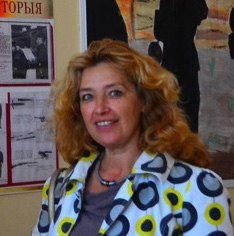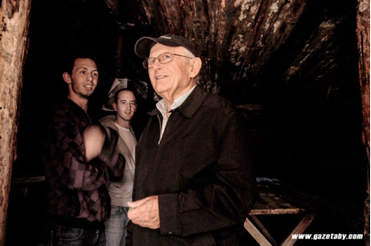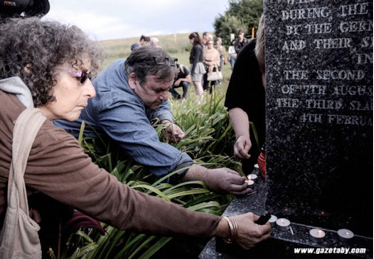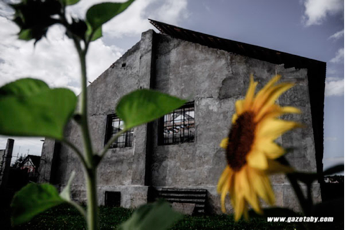Novogrudok, Belarus



The Museum of History and Regional Studies
The Museum of History and Regional Studies in Novogrudok deals with the history, culture and different faiths of the population of the remarkable, in many ways, area called Novogrudok district.
Small, but widely known, Novogrudok (Navaredok or Nowogródek) lies in the west of Belarus about 200 km from the Polish border and 150 km from Vilnius, the capital of Lithuania. It was important in the 13th c. as the first capital of the Grand Duchy of Lithuania, and is widely known today as the birth place of Adam Mickiewicz, the great Polish poet of the 19th c. Novogrudok has become a centre of Jewish history and Holocaust research in Belarus, where seminars on teaching about the Holocaust for secondary school teachers and Museum workers from the whole of Belarus have been regularly held since 2003. At the beginning they were organized with the London Jewish Cultural Centre on behalf of the International Task Force together with the Republican Holocaust Foundation (Belarus). Each time 40 teachers from all the regions of the Republic participated.
Studying the Holocaust is not included in school programs in Belarus but the conferences made the importance of Holocaust research obvious. Practically all the teachers who were with us carry out research in their own places and regions. Some have made exhibitions at schools; children present their research papers at yearly conferences in Brest and in Moscow. Many teachers have displayed deep interest in Jewish culture and use the materials they receive at our conferences in their courses on World Culture.
There is no officially established Remembrance Day of Holocaust victims in Belarus but many teachers we are working with organize special commemorations with schoolchildren either on January 27 or on other dates related to Holocaust events in their locations as well as take care of the gravesites (Dyatlovo, Ivatsevichi, Grodno, etc.).
We have cooperated with the Russian Research and Educational Holocaust Centre in Moscow and the All-Ukrainian Holocaust Centre ‘Tkuma’ for many years so that teachers and schoolchildren from Belarus have been able to participate in international conferences in Russia and the Ukraine.
In 2011 the Museum organized a seminar for Museum workers of Belarus - ‘Jewish history and culture is part of the history and culture of Belarus’ with lecturers from England (the LJCC), Israel and Poland (the Museum of History of Polish Jews, Warsaw). In 2012 I took the first group of 25 Museum workers and teachers from Belarus to a seminar to Yad Vashem (Israel).
The Museum of History and Regional Studies in Novogrudok was established in 1987 and opened to the public in 1992. It was the first Museum in Belarus to speak about the Jews and to present the history of the Jewish community of Novogrudok in the permanent exhibition. Why? Not because we were so very much advanced in Jewish history research, but because in 1992 we established contact with a descendant from Novogrudok, Mr. Jack Kagan who lives in London.
Jack was born in our town in 1929, lived through the three years of German occupation during WWII in the town, lost his family in the Holocaust that befell the Jews of Novogrudok and 50 years afterwards he contributed greatly to the restoration of the once famous shtetl of Novogrudok and the unique resistance shown by the Jews of Novogrudok during the war.
Mr. Kagan helped us to discover and research a very rich and prominent history of the Jewish community of Novogrudok and we, in turn, gladly supported his initiative to commemorate the victims of the Holocaust in Novogrudok. He initiated the establishment of new monuments at the places of massacres because he wanted to replace Soviet monuments on the grave sites, which stated that “peaceful Soviet citizens were murdered there by German fascist invaders”. I found documents in the archive to prove that Jews were murdered there and I assisted in his negotiations with the Mayor of Novogrudok.
In August 1993 about 70 people from Israel, the USA, Belgium and Australia – former Novogrudokers and members of their families – came for the opening of the two memorials. In June 1994 another group of 30 Novogrudokers from different countries arrived for the opening of the third memorial. There were several visits more, when Mr. Kagan organized trips for Novogrudokers to visit the town which they all cherished in their memories. Thus, since the beginning of the 1990s, contact with the Jewish Diaspora from Novogrudok was established and the Museum has continued to keep it active, receiving groups and individual visitors and providing assistance in genealogical research.
We arranged a small exhibition at the Museum telling the history of our Jewish community and about the events of the Holocaust, the escape through the tunnel and the resistance to the Nazis organized by the Bielski brothers.
In 1995 the Committee of Novogrudokers in Israel undertook a project of preserving the old Jewish cemetery in Novogrudok. With the money collected in the Diaspora, the fence around the cemetery was built and a granite memorial to the memory of the Jewish community of Novogrudok was erected. This cemetery is now taken care of by the Agricultural Lyceum, where in 2007 we arranged an exhibition of the Jewish Resistance Museum.
This had been preceded by archeological research in order to establish the entrance of the tunnel which was arranged by the Museum in 2002. A documentary was made in 2000 by BBC Bristol about the Bielski partisans’ survival in the forests for Ray Meer’s program “Extreme Survival”. This was carried out with the assistance of the Museum.
The project to arrange an exhibition was supported by the International Task Force and realized in 2007. Jack Kagan helped to collect information and photos and reconstructed the events in his testimony which was specially published for the opening in two languages – Russian and English. His testimony translated into German by Hartmut Winterfeldt, was also published by Osteuropa – Vorpommern Freundschaftsgesellschaft in Schwerin in 2012.
One more documentary called ‘Escape!’ about the most successful escape in Nazi occupied Europe when the last 250 prisoners built a tunnel and all escaped from the guarded labor camp, was filmed in August 2012. Fifty children and grandchildren of the escapees and three participants in the escape – Isroel Kolachek, Jack Kagan and Riva Bernstein – participated in the archeological research of the tunnel organized by the Museum during the filming. It aims to establish the route of the tunnel, to find the exit, making it possible to reconstruct certain parts of the tunnel and create a memorial. This is a new project the Museum and will be realized in 2013-14.
In 1998 Jack Kagan and Dov Cohen published a book of memoirs “Surviving the Holocaust with the Russian Jewish Partisans”. I helped to find documents about the Bielski partisans in the National Archive of the Republic of Belarus and translated them into English for him. The book contains very important German documents that together with personal stories of the two cousins, makes it an important document in itself. I translated it into Belarusian and published it in Belarus in 1999. The book launch was in Novogrudok and at the Museum of the Great Patriotic War in Minsk. It was one of the first books about the Holocaust published in Belarus. In 2011 I translated the book into Russian and it was published in Moscow with some additional documents, the most important of which is the diary of Benjamin Berkowicz written in the ghetto in Novogrudok.
The diary was found in the archive of the Jewish Historical Institute in Warsaw. In 2010 Michael Kagan, Jack’s son, and I carried out some research and found the Polish family in Warsaw that had rescued the diary. Michael Kagan wrote a radio play based on Berkowicz’s diary. We found Jadwiga Kaminska, the daughter of Romuald Pielachowski who saved the diary, in Warsaw and interviewed her on video. We hope to make a documentary based on this diary which is very different from other documents of such kind.
Several other initiatives concerning Novogrudok are worth mentioning:
A group of children from school #7 took an optional course in history led by Dzhemma Nevzhinskaya. They thoroughly studied the book “Surviving the Holocaust with the Russian Jewish partisans” by Jack Kagan and Dov Cohen and prepared a lecture on the Holocaust which they delivered to each class at their school in December, on the eve of the anniversary of the first massacre in Novogrudok. On December 8, the very day when the massacre took place, they go every year to the grave site to hold a remembrance ceremony there. With the assistance of our Museum, the schoolchildren made a model of the ghetto in Novogrudok for their school museum.
Another initiative belongs to the Agricultural Lyceum which houses the Jewish Resistance Museum. The director of the Lyceum supported our proposal to arrange an exhibition on their campus and allocated rooms in the former living barracks of the ghetto. At present, the students of the Lyceum take care of the Jewish cemetery and the graves of those from the last massacre.
In the years following the opening of the exhibition, the youth organization of high school #2 in Novogrudok was named after Tuvia Bielski on the initiative of the teachers and pupils. They arranged a Museum at school, and part of its exhibition is devoted to Jewish history of Novogrudok . On our recommendation they participated in the project ‘Virtual Shtetl’ of the Museum of History of Polish Jews (Warsaw) in 2011.
Schoolchildren of Form 6 E from school # 5 took the name of Jack Kagan for their pioneer organization in 2010.
In 2009 we organized archeological research at the Bielski camp site in the Naliboki dense forest. In 2002, the site of the camp was located precisely, when our Museum made contact with Leokadiya Lankovich, a Pole from the village of Kletishche.
The Bielski story is one of the most important in the history of Jewish resistance during WWII and it is important to include it into the educational syllabus of Jewish resistance and Holocaust studies for youth and students.
Tuvia Bielski, the commander of the largest Jewish partisan detachment in the history of Jewish resistance during WWII, proclaimed rescuing Jews as his main aim which totally distinguished this unit from other partisan groups. What he did was an unprecedented act of rescuing Jews by Jews in the forest, allowing him to rescue about 1200 Jews.
A collection of artifacts found during archeological research is presented at the exhibition ‘Courage and Compassion. The legacy of the Bielski brothers’ organized by the Florida Holocaust Museum (USA).
These initiatives show a change in public awareness of the population of Novogrudok. It has been common practice in the Soviet Union to praise heroes of the war, erect monuments to commemorate great victories, to speak about thousands of those who had perished and lay flowers at the monuments of unknown soldiers. As a result of the activities of the Museum in Novogrudok, we can observe a process of reintegration of Jewish history and remembrance about the Holocaust in the history and in the awareness of inhabitants of Novogrudok and Belarus in general.
Tamara Vershitskaya
April 2013
See also:
http://www.courageandcompassionexhibit.com/resources-and-links.aspx


by Tamara Vershitskaya







